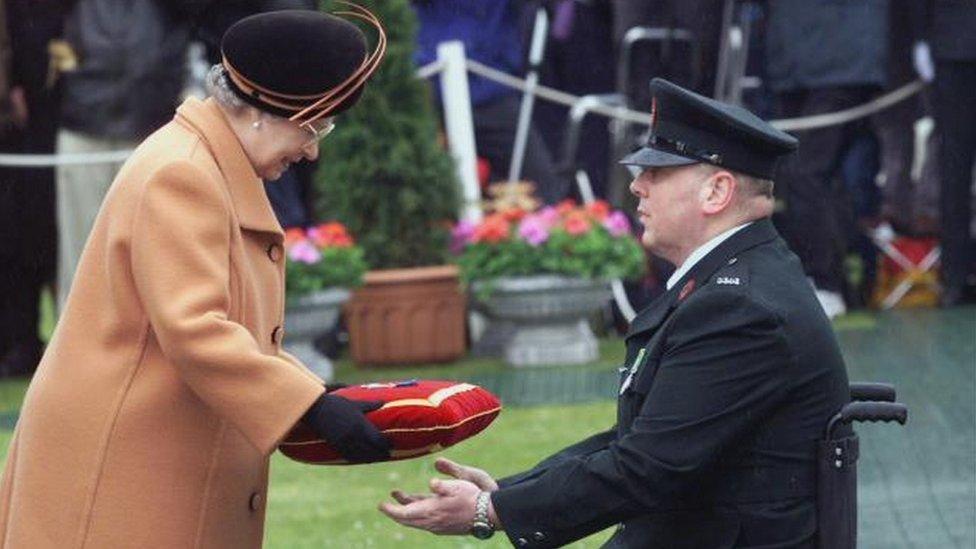Platinum Jubilee: The Queen and Northern Ireland through the years
- Published
Platinum Jubilee: The Queen in Northern Ireland through the years
The Queen has made 25 visits to Northern Ireland, including three before she ascended to the throne.
She was 19 years old when, as Princess Elizabeth, she visited Stormont with her father, King George VI, and her mother Queen Elizabeth.
The royal visit in 1945 also included trips to Belfast City Hall, Queen's University and Botanic Gardens.
At the time, Northern Ireland, like the rest of the United Kingdom, was recovering from World War Two.
Further visits by the young princess followed in 1946 and 1949.
Her father died in 1952 and after an extended period of mourning, Queen Elizabeth II was crowned in June 1953 and subsequently went on a coronation tour.
She went to Hillsborough Castle, accompanied by her husband, the Duke of Edinburgh.
The royal couple were greeted by two Lambeg drummers. One of the drums was preserved and played again outside the castle last year as a tribute to Prince Philip on the day of his funeral.
With Belfast renowned for its shipbuilding, the Queen was asked to launch the passenger liner Southern Cross at Harland and Wolff shipyard in August 1954.
The royal couple did not visit Northern Ireland again until the summer of 1961, when they arrived at Carrickfergus on the Royal Yacht Britannia.
Continuing the travel theme, the Queen officially opened a Belfast bridge named in her honour in July 1966.

The Queen Elizabeth II Bridge was opened in 1966
The Queen Elizabeth II bridge crosses the River Lagan and is now one of the busiest routes in and out of the city.
During the trip, a brick was thrown at the royal couple's car as it was driven through the city centre. It hit the bonnet of the vehicle but neither the Queen or the duke was injured.
It was another 11 years before they returned to Belfast.
The visit in 1977 was part of the Queen's Silver Jubilee tour. Once again, the royal couple travelled in the royal yacht and large crowds lined the County Down coast to watch the vessel sail up Belfast Lough.

The royal tour also included the north Antrim coast and a visit to the new University of Ulster in Coleraine.
By this time, the Troubles were raging in Northern Ireland and security around the royal visit was stepped up. There were republican protests, and the words 'stuff the jubilee' were painted on some walls.
The Queen did not visit at all during the 1980s. When she returned in 1991, it was a relatively short visit, to honour the Ulster Defence Regiment at a ceremony at Thiepval Barracks in Lisburn.

Gradually, the security situation improved as the peace process developed and the number of royal visits increased.
The Queen hosted a number of garden parties at Hillsborough Castle.
The signing of the Good Friday Agreement in 1998 led to power-sharing at Stormont, the creation of new political structures and a new era in Anglo-Irish relations.
It also meant major changes to policing with the Royal Ulster Constabulary (RUC) becoming the Police Service of Northern Ireland (PSNI).
In April 2000, the Queen presented the RUC with the highest award for bravery, the George Cross.

The Queen presented the George Cross to Constable Paul Slaine of the RUC at Hillsborough Castle
During that decade, she visited Northern Ireland on nine different occasions. At the same time, diplomatic and personal relations were developed with the then Irish head of state, President Mary McAleese.
This built on a meeting in 1993 at Buckingham Palace with Mrs McAleese's predecessor as president, Mary Robinson. It was the first meeting between the British and Irish heads of state.
Delicate work in the background culminated in an historic visit by the Queen to Dublin in 2011, the first by a British monarch since the creation of the Irish Republic.
It was a milestone in Anglo-Irish relations and rather than being simply a short, symbolic visit, the Queen stayed for four days.

The Queen made a historic visit to Dublin in 2011
In a speech at Dublin Castle, she began in Irish saying: "A Uachtaráin agus a chairde (President and friends)."
Another significant moment came the following year when the Queen and Sinn Féin's Martin McGuinness shook hands.
He was a former leading member of the IRA. The Queen's cousin, Lord Mountbatten, was killed by the IRA in 1979.
For both the Queen and Martin McGuinness, the encounter was a step outside their comfort zone. Some of their supporters may not have welcomed the handshake.

The Queen shook hands with Martin McGuinness at the Lyric Theatre in Belfast
Looking back at the Queen's role in the peace process and reconciliation, a retired civil servant once said: "Her Majesty does not just name bridges, she builds them."
In 2012, on a visit to Enniskillen, she attended a service in a Protestant place of worship and then walked across the road to a Catholic church.
The walk between St Macartin's Cathedral and St Michael's Catholic church was cheered by crowds on both sides of the street.
Since that visit 10 years ago, the Queen has visited Northern Ireland three times. She had to cancel a visit last year for health reasons.
She had been due to attend an inter-denominational church service in Armagh marking 100 years since the establishment of Northern Ireland, and the partition of Ireland in 1921.
Now in her 97th year, the Queen has got to know Northern Ireland well over the past eight decades.
After the cancellation of her visit in October, a Buckingham Palace spokesperson said: "The Queen sends her warmest good wishes to the people of Northern Ireland and looks forward to visiting in the future."
- Published2 June 2022

- Published18 May 2011

- Published19 May 2011
